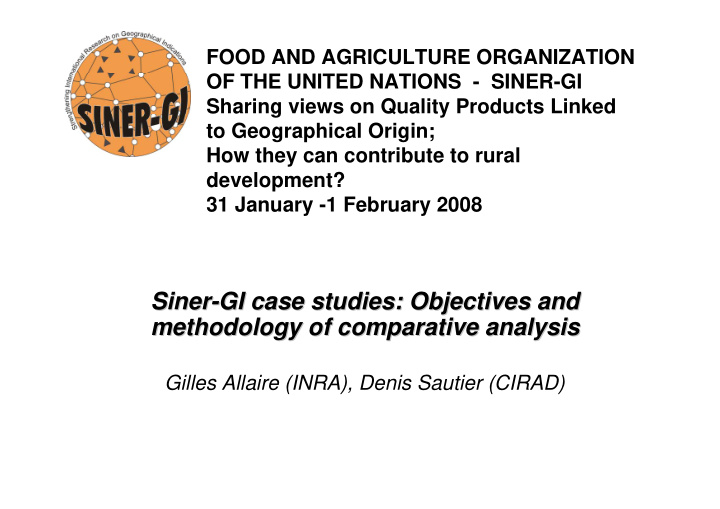



FOOD AND AGRICULTURE ORGANIZATION OF THE UNITED NATIONS - SINER-GI Sharing views on Quality Products Linked to Geographical Origin; How they can contribute to rural development? 31 January -1 February 2008 Siner- -GI case studies: Objectives and GI case studies: Objectives and Siner methodology of comparative analysis methodology of comparative analysis Gilles Allaire (INRA), Denis Sautier (CIRAD)
SINER GI Strengthening International Research on Geographical Indications www.origin-food.org • UE funded project (2006-2008) • Continuation of the Dolphins Project on European GI • Siner-GI project addresses GI in the global market as a global issue
SINER-GI PROJECT OBJECTIVES • To understand what are the conditions for successful GI qualification ? – Not only stable and profitable position on the market – But positive impacts on local/national economic, social, health, environmental public issues • To understand what are supporting policies and collective initiatives to this purpose ? – Criteria for transferability of GIs good practices • To address these issues considering several scenarios regarding the international trade regime
STEP 1: Case Studies • Building up methodology (WP1-WP4) – The GI system is “the set of actors who are effectively engaged in creating value and improving the strategic marketing position of the GI product by spontaneous individual or organized collective action, and those who are engaged in the activation and reproduction of those local resources (natural resources, knowledge, social capital) which make the GI product specific” – Several dimensions of GI systems: the market structure, the supply chain organisation, the stakeholders and policies supports, the system management and governance, the technology and product qualification procedure… • Inventory of GIs in a large set of countries � database on our website (60 cases) • Implementation of 12 case studies (June-October 2007)
Sampling strategy: Sampling strategy: legal and institutional framework legal and institutional framework Limited protection (repression of abuses) Florida oranges Rooibos South Africa Effective Limited implementation implementation Roquefort Jin Hua ham High level of protection (atribution of rights)
Sampling strategy: Sampling strategy: Market stakes and support policy Market stakes and support policy Stake: Market restructuring Pico Duarte coffee Paprika Public Sectorial support support Pampean beef Tequila Market enlargement
STEP 1: Case Studies (result) Typology of GI systems Recognition Rural development Market strategic stake Policy policy Restructuring Enlargement public or NGO support Melton Mowbray pork Roquefort P1 : High and for Rural Dev. Pie effective protection sectorial support (firms) Tequila Pico Duarte coffee public or NGO support for rural dev. Kajmak cheese P2: High protection, limited or no Jinhua Ham implementation sectorial support Paprika Pampean Beef Blueberry Lac St Jean public or NGO support P3: Protection through for rural dev. trademarks / effective Sectorial support Florida oranges public or NGO support P4: Protection through Rooibos for rural dev. trademark system: limited sectorial support Chontaleño cheese Basmati rice (Pak.)
Siner- -GI Case studies and GI Case studies and Siner Legal situation of GIs in the world (2006) (2006) Legal situation of GIs in the world Xin-Hua ham Lac St. Jean Blueberry Paprika Kajmak cheese Florida oranges Tequila Basmati Pico Duarte coffee Chontaleño cheese Basmati rice Pampa gaucha da CM Beef Rooibos Argentina Pampa Beef 8
STEP2: Forecast Methodology : GI future • To contrast different aspects and trends according tothe new international trade regime, we consider three scenarios . • These scenarios concern the position of origin (GI) as a marketing tool in a complex global market universe in which private and public standards play an important role in the dynamics of markets: – CONVERGENCE on GI visions and “origin” as integrator for different quality attributes (organic, fair trade…) – DIVERGENCE on GI visions and “origin” weakening as market sign – PLURALITY of GI visions and of quality schemes and forums
STEP3: Comparative Analysis Methodology • Types of geopolitical contexts – Diversity of the protection schemes and support policies • Types of GI systems/markets – Diversity of economic trajectories of the GI systems (success/failure) • Variability of the impacts according to – the scenarios – the contexts – the GI systems
Recommend
More recommend